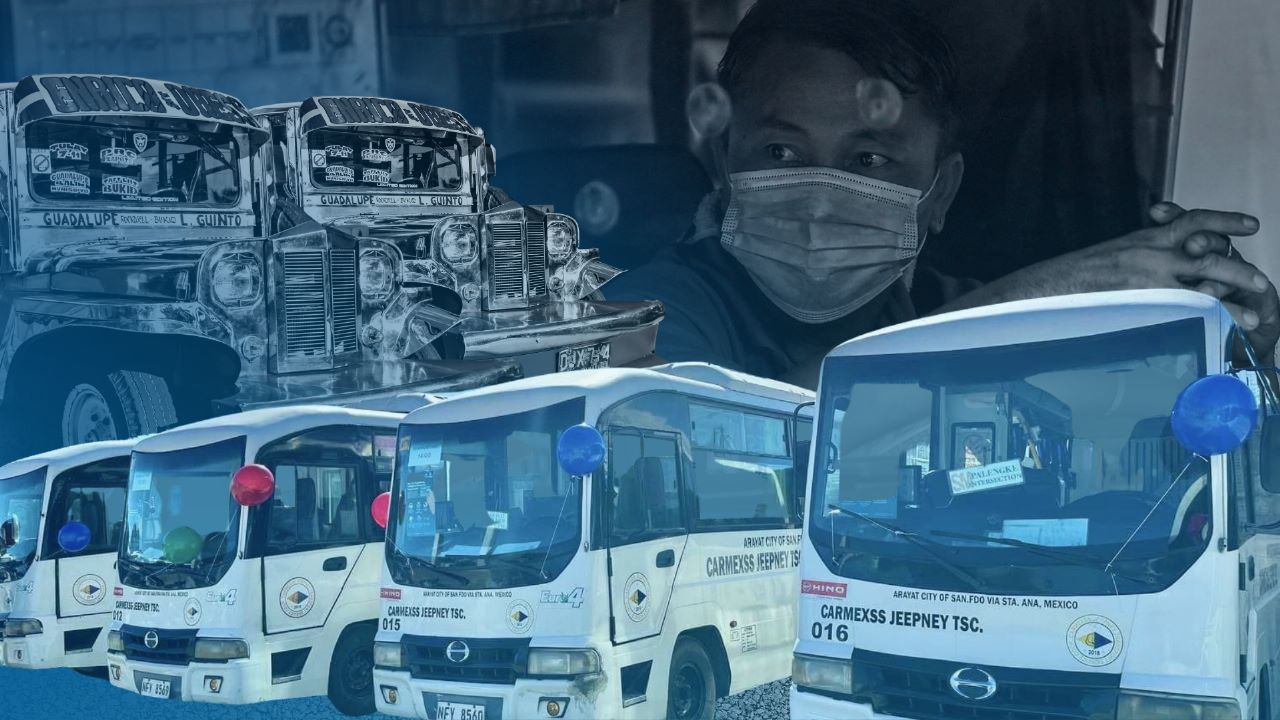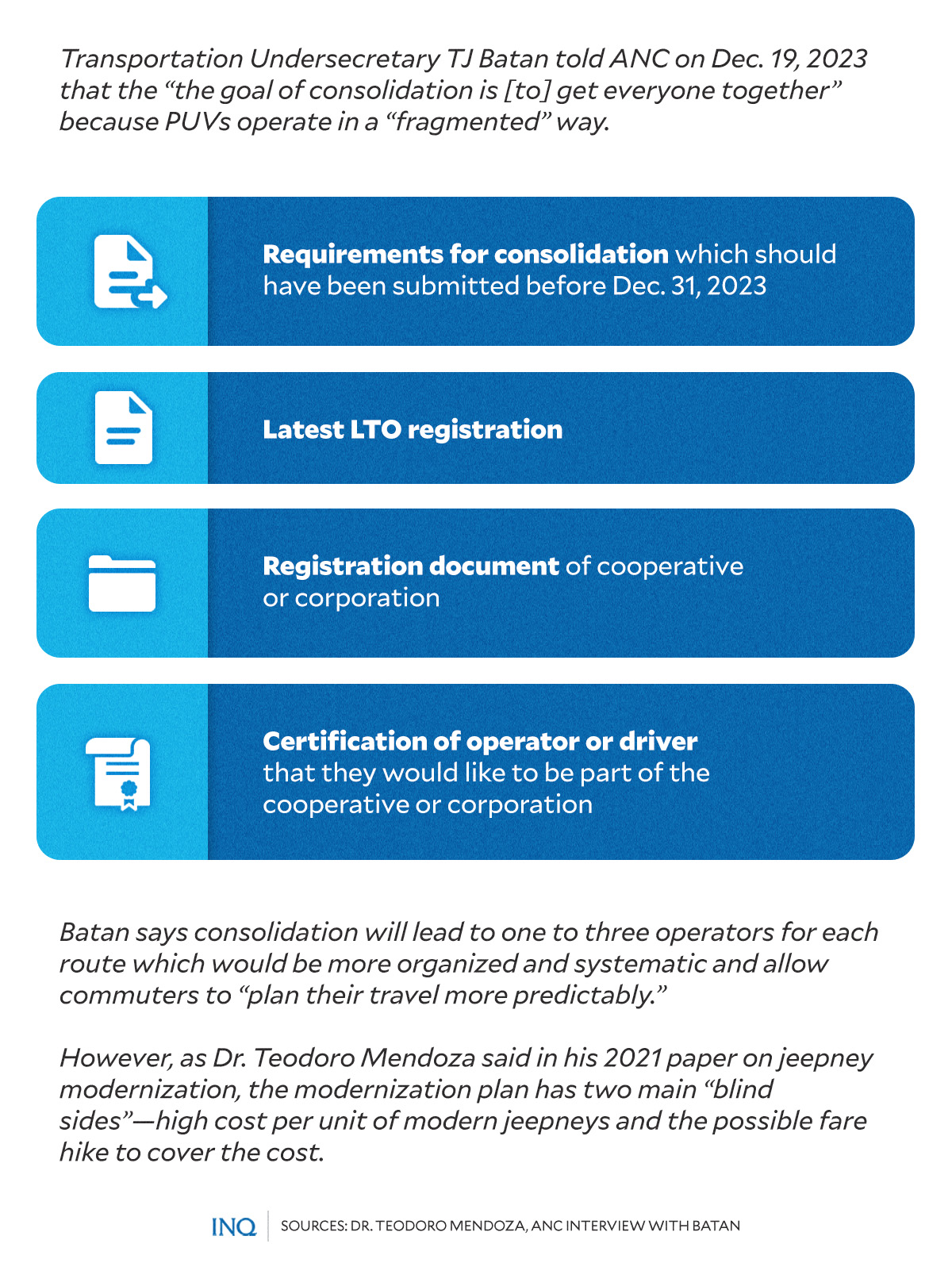MANILA, Philippines—The first step to the Public Utility Vehicle Modernization Program (PUVMP), industry consolidation, where operators are required to form cooperatives or similar legal entities, is not as simple as it may seem.
Transportation Undersecretary TJ Batan told ANC last Dec. 19 that “to get everyone together,” PUVs should be consolidated, stressing that at present, PUVs in the Philippines, especially in Metro Manila, operate in a “fragmented” way.
He pointed out that with industry consolidation, there will be one, two, or three operators for every route, making it possible for commuters to “plan their travel more predictably.”
“The goal here is to make the system more reliable,” he said, stressing that when there are consolidated operators plying a designated route in a systematic manner, dispatching and scheduling will become centralized.
READ: PUV consolidation deadline stays — DOTr
So to convince PUV operators to consolidate their franchises before the deadline on Dec. 31, Batan said the Department of Transportation (DOTr) made the process less difficult and asked only for these requirements:
- Latest registration of the PUV unit/s in the Land Transportation Office
- Registration document of the cooperative or corporation
- Certification of the driver or operator that he or she would like to become part of cooperative or corporation
Operators who have been consolidated before the deadline can still operate until all units have been modernized, but those who did not consolidate will have only a month more to operate.
As the Land Transportation Franchising and Regulatory Board (LTFRB) said, PUVs that have not been consolidated past the yearend deadline can still operate until Jan. 31. There was no extension, however, of the deadline to consolidate.
READ: PUV operators get month-long reprieve
The local think tank Ibon Foundation, citing data from the DOTr, pointed out on Dec. 13 that an estimated 71,395 PUVs nationwide have not yet been consolidated, consisting of 64,639 public utility jeepneys (PUJs) and 6,756 utility van express (UVE) units.
The 64,639, it said, is only 43 percent of the total PUJs in the Philippines, while the 6,756 is 35 percent of all UVE units, so there are only 57 percent PUJs and 65 percent UVE units consolidated.
But in Metro Manila, where there are nine million jeepney passengers every day, the LTFRB told the GMA-7 program Unang Hirit that only 40 percent of PUJs have consolidated for the PUVMP, far less than the nationwide average of about 70 percent as of Jan. 1.
‘Nothing to go back to’
Mody Floranda, national president of the drivers and operators’ group Piston, previously told INQUIRER.net that they are not totally against the PUVMP, saying that “what we are opposed to is the way the government is implementing the program.”
“Big businesses, especially those outside the Philippines, are advantaged,” he said.
RELATED STORY: Pimentel to DOTr: Name suppliers in PUV modernization program
Floranda said once you consolidate your franchise in a cooperative or corporation, you surrender your right to have an individual franchise: “Once you fail to shoulder the weight of expensive modernization, you have nothing to go back to.”
“What happens to the consolidated franchise of your cooperative? It will be bid out by the LTFRB to large corporations who have the capacity to pay for imported minibuses promoted by the government,” he said.
According to the DOTr’s Omnibus Franchising Guidelines, only cooperatives or corporations with at least 15 vehicles would be allowed to apply for new franchises, restricting small-capacity vehicles from main roads.
As a result, some small operators have protested, stressing their concern that they do not have enough resources to complete the requirement of 15 units.
Ricardo Rebaño, president of the Federation of Jeepney Operators and Drivers Association of the Philippines, pointed out that operators would need to pay a monthly amortization of P475,000 to operate 15 modern vehicles.
According to Floranda, “only big corporations with single consolidated franchises have the financial capacity to purchase and fully comply with the current PUVMP schemes.”
Thousands ‘to be displaced’
For Ibon Foundation, President Ferdinand Marcos Jr.’s refusal to extend the deadline for franchise consolidation showed “how callous his administration is to ordinary Filipinos.”
READ: Marcos takes firm stance on deadline for PUV consolidation
“The livelihood of tens of thousands of PUV drivers and operators will be disrupted and millions of people will have an even harder time commuting,” Ibon said, adding that millions will be affected and not just a “minority,” contrary to what Marcos said.
“The Marcos administration is indifferent to the plight of PUV drivers, operators and commuters and instead is more concerned with private sector interests that will benefit the most from the forced consolidation,” it said.
RELATED STORY: Noncompliant PUVs: We’ll stay on road until barred
But for the National Center for Commuter Safety and Protection Inc., the “defiance” of some PUV drivers and operators was tantamount to “hostage-taking,” with its convenor, Elvira Medina, saying that the delay is “discomfort” to commuters.
“What I’ve been telling […] before and even now, what these people are doing is that they are blackmailing the government and using commuters as hostages. [They say] ‘we won’t be on the road, your commuters will be disadvantaged’,” she said in a media forum organized by Capstone-Intel Corporation.
“Isn’t that hostage-taking,” Medina said, referring to the series of transport strikes by thousands of PUJ drivers and operators this year. Last Dec. 29, thousands protested in Manila, too, to call for an extension of the consolidation deadline.
As pointed out by Ibon Foundation, the mass transport crisis will worsen because of the limited number of consolidated PUVs and the lack of a clear government program to deal with the huge gap after the forced consolidation deadline.
But this does not mean that PUV operators who do not want to consolidate should be blamed. As stated in a Senate resolution last year, “the LTFRB should not coerce PUV operators into complying with their guidelines without addressing the sector’s concerns.”
Efficient routes ‘needed’
Ibon Foundation stressed that even with consolidation, commuting time is also not guaranteed to be shorter, “as the government has been inefficient in planning new routes.”
As explained by the LTFRB, it has been working on providing rationalized and efficiently planned routes that would be responsive to the demands of the passenger.
Its route rationalization, it said, is a comprehensive and strategic assessment of the current public transport system based on passenger demand, location of major movement and future travel demand patterns.
In his paper “Public Transport Rationalization as a means to Sustainability,” Dr. Cresencio Montalbo Jr. wrote that each day, 8,959,000 individuals ride public utility jeepneys (PUJ) while 1,865,000 people ride public utility buses (PUB).
Montalbo, who is part of the University of the Philippines’ School of Urban and Regional Planning, said that in Metro Manila, there are 677 PUJ routes with a length of 10.9 kms. There are 82 PUB routes with a length of 36.7 kms.
Montalbo said he wanted to develop an “integrated public transport system” that would enable the efficient movement of people in Metro Manila through “ecologically sustainable travel” that was cost effective.
To have his goal realized, he proposed a “16 mass transit trunk-feeder routes linking areas of highest demand, creating [a] network of transit routes [and] strong interchange between routes.”
He also proposed 59 secondary bus routes that will back mass transit. The proposal included standalone routes to provide access to important residential and employment areas in Metro Manila.
RELATED STORY: Last-ditch effort in SC vs PUV modernization



